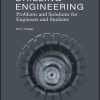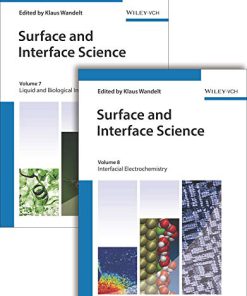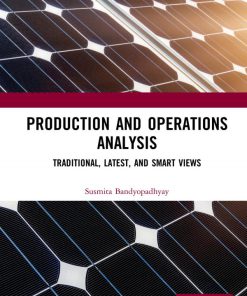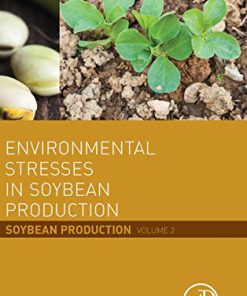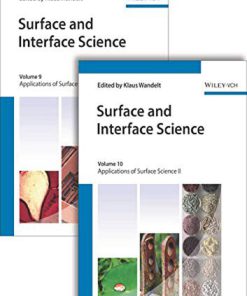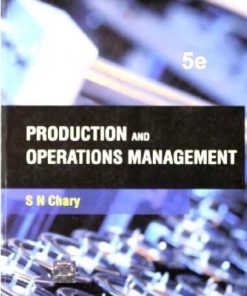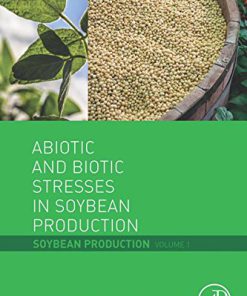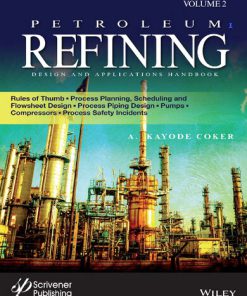Surface Production Operations Volume IV Pumps and Compressors 1st edition by Maurice Stewart ISBN 0128099224 9780128099223
$50.00 Original price was: $50.00.$25.00Current price is: $25.00.
Surface Production Operations Volume IV Pumps and Compressors 1st edition by Maurice Stewart – Ebook PDF Instant Download/Delivery: 0128099224, 978-0128099223
Full download Surface Production Operations Volume IV Pumps and Compressors 1st Edition after payment
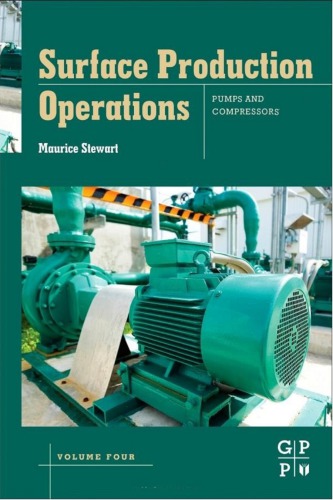
Product details:
ISBN 10: 0128099224
ISBN 13: 978-0128099223
Author: Maurice Stewart
For over thirty years, the Surface Production Operations Series has taken the guess work out of the design, selection, installation, operation, testing, and troubleshooting of surface production equipment. The fourth volume in this series, Pumps and Compressors is directed to both entry-level personnel and practicing professionals looking for an up-to-date reference book on managing, evaluating, sizing, selecting, installing, operating and maintaining pump and compressor systems. Packed with examples drawn from years of design and field experience, this reference features many charts, tables, equations, diagrams, and photographs to illustrate the basic applications including pump hydraulics, centrifugal and reciprocating compressor applications, compressor performance maps, pump performance curves, pump and compressor testing and installation, and many more critical topics. Packed with practical solutions Surface Production Operations: Pumps and Compressors delivers an essential design and specification reference for today’s engineers.
- Covers application and performance considerations for all types of pumps and compressors
- Delivers hands-on manual for applying mechanical and physical principles to select and design pump and compressor systems, supported by many tables and diagrams
- Gives expert advice on how to apply design codes and standards such as API 610, API 674, ANSI B78.1, API 617, API 11P, API RP 14C and the Hydraulic Institute
Surface Production Operations Volume IV Pumps and Compressors 1st Table of contents:
- Chapter 1: Overview of pumps, compressors, and drivers
-
Chapter 1: Overview of Pumps, Compressors, and Drivers
- Section 1.1 introduces basic concepts related to pumps, compressors, and drivers.
- Section 1.2 outlines the scope and application of the content.
- Section 1.3 gives an organizational structure of the book, dividing the material into three parts: pumps, compressors, and drivers.
Chapter 2: Pump Fundamentals
- This chapter dives deep into the engineering and hydraulic principles behind pumps, covering everything from basic fluid types to complex systems such as hydrodynamics, power requirements, and pump selection.
- Topics like NPSH (Net Positive Suction Head), pump efficiency, and system head curves are covered thoroughly.
- Includes exercises and questions for a practical understanding.
Chapter 3: Centrifugal Pumps
- This section covers the engineering principles specific to centrifugal pumps, detailing their performance curves, viscosity effects, affinity laws, and system head curves.
- Parallel and series operation of pumps, suction considerations, and flow regulation are explored in detail.
- There are specific types of centrifugal pumps described, including horizontal, vertical, and multistage pumps.
- Troubleshooting, operational, and maintenance considerations are also addressed, making this section a comprehensive guide for centrifugal pump systems.
Chapter 4: Reciprocating Pumps
- Covers engineering principles specific to reciprocating pumps, including different types like plunger, piston, and diaphragm pumps.
- Provides in-depth analysis on pump performance, pressure, capacity, and speed.
- Details pump construction, fluid end components, and power end components with a focus on materials of construction, installation, and maintenance considerations.
- Reciprocating pump standards and selection criteria are discussed, making it a practical reference for choosing and maintaining these pumps.
-
Chapter 5: Rotary Pumps
5.1 Engineering Principles
-
5.1.1 Background
Overview of rotary pump technology, principles, and operation. -
5.1.2 Slip
Explanation of slip in rotary pumps and its impact on performance. -
5.1.3 Volumetric Efficiency
Discussion on how volumetric efficiency is measured and optimized in rotary pumps. -
5.1.4 Mechanical Efficiency
The factors affecting mechanical efficiency in rotary pumps, including friction and losses. -
5.1.5 Suction Considerations
Key factors influencing the suction process in rotary pumps, such as suction head and priming.
5.2 Rotary Pump Types
-
5.2.1 Eccentric Rotor
Rotary pumps that use an eccentric rotor design for fluid movement.-
5.2.1.1 Sliding Vane
The design and function of sliding vane pumps, where vanes slide in and out of the rotor to seal and move fluid. -
5.2.1.2 Flexible Vane
Overview of flexible vane pumps and how they work to maintain fluid flow.
-
-
5.2.2 Gear Pumps
Gear-based rotary pumps used in various applications.-
5.2.2.1 External Gear
The mechanics of external gear pumps, where two gears mesh to pump fluid. -
5.2.2.2 Internal Gear
Design of internal gear pumps, featuring one gear inside another to move fluids. -
5.2.2.3 Lobe
Explanation of lobe pumps, which use lobed rotors to move fluid without contact between the parts.
-
-
5.2.3 Screw Pumps
Types of rotary pumps utilizing screws for fluid movement.-
5.2.3.1 Single-Screw
Characteristics and application of single-screw (progressive cavity) pumps. -
5.2.3.2 Two-Screw
The operation and advantages of two-screw pumps for transferring liquids. -
5.2.3.3 Three-Screw
How three-screw pumps offer benefits in specific high-pressure or high-flow applications.
-
5.3 Rotary Pump Selection Guidelines
-
5.3.1 Eccentric Rotor
- 5.3.1.1 Vane
Selection criteria for eccentric rotor vane pumps based on application needs.
- 5.3.1.1 Vane
-
5.3.2 Gear
-
5.3.2.1 External Gear
Guidelines for selecting external gear pumps based on flow rate and pressure requirements. -
5.3.2.2 Internal Gear
Choosing internal gear pumps for different operating conditions. -
5.3.2.3 Lobe
Selection considerations for lobe pumps, suitable for handling viscous fluids.
-
-
5.3.3 Screw
-
5.3.3.1 Single-Screw
Factors in selecting single-screw pumps, particularly for progressive cavity applications. -
5.3.3.2 Two-Screw
Criteria for choosing two-screw pumps, often used for low to medium viscosity liquids. -
5.3.3.3 Three-Screw
Key selection guidelines for three-screw pumps, typically used for high-flow, high-pressure operations.
-
5.4 Rotary Pump Service Considerations
Important aspects to consider for maintaining and servicing rotary pumps, including troubleshooting common issues.
5.5 Rotary Pump Configurations
-
5.5.1 External Gear Rotary Pump (Fig. 5.15)
Detailed description and diagram of external gear rotary pumps. -
5.5.2 Internal Gear Rotary Pump (Fig. 5.16)
Explanation of internal gear pump configuration and its operational characteristics. -
5.5.3 Single-Screw (Progressive Cavity) Rotary Pump (Fig. 5.17)
Overview of the single-screw pump design and its progressive cavity pumping action. -
5.5.4 Two-Screw Rotary Pump (Fig. 5.18)
Two-screw pump configuration and application in moving low- to medium-viscosity fluids. -
5.5.5 Three-Screw Rotary Pump (Fig. 5.19)
Description of the three-screw pump configuration, used in applications requiring high-pressure operation.
5.6 Installation Considerations
-
5.6.1 Drivers
Considerations when selecting drivers for rotary pumps, including motor and engine options. -
5.6.2 Instrumentation and Control Considerations
The importance of instrumentation and controls in ensuring smooth rotary pump operation. -
5.6.3 Strainers
The role of strainers in protecting pumps from debris and contaminants. -
5.6.4 PSVs (Pressure Safety Valves)
Selection and installation of pressure safety valves to protect rotary pumps from overpressure situations. -
5.6.5 Lubrication Prior to Start-Up
Proper lubrication procedures before starting a rotary pump to ensure smooth operation and longevity.
Chapter 6: Special Purpose Pumps
6.1 Artificial Lift Pumps
-
6.1.1 Electric Submersible Pumps (ESPs)
Types of ESPs used for artificial lifting, particularly in oilfields and wells.-
6.1.1.1 Down-Hole Oilfield ESP
Application of ESPs in oilfields for lifting crude oil from deep wells. -
6.1.1.2 Shallow Water Well Pumps
Use of ESPs for lifting water from shallow wells in various industries.
-
-
6.1.2 Sucker Rod Pump
Overview of the sucker rod pump and its application in oil extraction. -
6.1.3 Hydraulic Turbine Driven Pumps
How hydraulic turbine-driven pumps are used for artificial lift in oil and gas operations. -
6.1.4 Gas Lift Systems
Description of gas lift systems and how they use gas injection to assist in lifting fluids.
6.2 Air-Diaphragm Pumps
Explanation of air-operated diaphragm pumps, which use compressed air to move fluids.
6.3 Regenerative Turbine Pumps
Regenerative turbine pumps, which use high-speed rotation to impart energy to fluids, suitable for high-pressure applications.
6.4 Jet Pumps
Overview of jet pumps and their use in applications requiring fluid movement with minimal mechanical parts.
6.5 Slurry Pumps
Pumps designed for handling abrasive materials and slurries in industries such as mining and construction.
6.6 Peristaltic Pumps
Working principles and applications of peristaltic pumps, ideal for transferring liquids that require careful handling or are prone to contamination.
-
Chapter 7: Compressor Fundamentals
7.1 Engineering Principles
-
7.1.1 Background
An introduction to compressors and their applications in various industries. -
7.1.2 Compressor Classification
Compressors can be classified based on several criteria such as speed, structure, and operating principles. -
7.1.3 Types of Compressors
- High-speed vs. Low-speed “separable” units
- High-speed separable compressors
- Low-speed integral engine compressors
- Rotary vane compressors
- Rotary screw (helical lobe) compressors
- Centrifugal compressors
7.2 Thermodynamic Principles of Compressors
-
7.2.1 Introduction
An overview of the basic thermodynamic principles applied to compressors. -
7.2.2 General “Perfect” Gas Law and Compressibility Factor
The ideal gas law and the concept of compressibility factors in compression processes. -
7.2.3 Gas Properties
Properties of gases relevant to compression, including mixtures, specific gravity, and humidity.-
7.2.3.1 Gas Mixtures
Understanding how different gases mix and the effects on compression. -
7.2.3.2 Specific Gravity
The importance of specific gravity in compressor performance. -
7.2.3.3 Humidity
The effects of humidity on the compression process.
-
-
7.2.4 Flow Measurements
Methods and units used for measuring gas flow in compressors.- 7.2.4.1 MMSCFD (Million Standard Cubic Feet per Day)
- 7.2.4.2 Moles per Hour (MPH)
- 7.2.4.3 SCFM (Standard Cubic Feet per Minute)
- 7.2.4.3.1 Mass (weight) flow
- 7.2.4.4 ACFM (Actual Cubic Feet per Minute)
- 7.2.4.5 Other conventions for standard conditions
-
7.2.5 Application of Compression Thermodynamic Theory
Practical applications of thermodynamic principles in compressor operations.- 7.2.5.1 Introduction
- 7.2.5.2 Isothermal Compression
- 7.2.5.3 Isentropic (Adiabatic) Compression
- Adiabatic Head
- Adiabatic Discharge Temperature
- Adiabatic Gas Horsepower
- Adiabatic Efficiency
- Thermodynamic Diagrams
- 7.2.5.4 Polytropic Compression
- Polytropic Efficiency
- Polytropic Head
- Polytropic Discharge Temperature
- Polytropic Gas Horsepower
- Thermodynamic Diagrams
- 7.2.5.5 Miscellaneous Considerations and Clarifications
- 7.2.5.1 Introduction
7.3 How to Select a Compressor
-
7.3.1 Preliminary Selection Considerations
Key factors to consider when choosing a compressor. -
7.3.2 Approximating the Number of Stages
Methods for approximating the required number of stages in a compressor. -
7.3.3 Approximating Brake Horsepower (BHP)
Various methods for approximating the brake horsepower required for a compressor.-
7.3.3.1 GPSA “Quick Look” Approximation Curve
- 7.3.3.1.1 Determination of the k-value (Ratio of Specific Heats)
- 7.3.3.1.2 Calculating Total Compression Ratio (Rt)
- 7.3.3.1.3 Determining BHP/MMSCF from the curve
- 7.3.3.1.4 Correcting for Suction Temperature and Pressure Base
- 7.3.3.1.5 Altitude Correction
- 7.3.3.1.6 Specific Gravity and Low Inlet Pressure Corrections
-
7.3.3.2 Approximate BHP Formula
-
7.3.3.3 Selecting the Type of Compressor
-
-
7.3.4 Procedure for More Accurate Determination of Stages and Horsepower Detailed steps for determining the number of stages and horsepower more accurately.
- 7.3.4.1 Determination of Gas Discharge Temperature
- 7.3.4.2 Accurate Determination of Brake Horsepower
- 7.3.4.3 Determination of Interstage Pressure Loss
- 7.3.4.4 Compressor Process, Safety, and Piping Considerations
7.4 Design Considerations
-
7.4.1 Overview
An overview of key design considerations when selecting and designing compressors. -
7.4.2 Compressor Duty
The role of the compressor in the system and how its duty affects design. -
7.4.3 System Resistance and Characteristic (Performance) Curves
- 7.4.3.1 System Resistance Curve
- 7.4.3.2 Compressor Characteristic (Performance) Curve
- 7.4.3.3 Gas Analysis
- 7.4.3.4 Site Conditions
- 7.4.3.5 Service Requirements
7.5 Application and Selection Criteria
-
7.5.1 Selection Basis
Criteria for choosing the appropriate compressor based on application needs. -
7.5.2 Approximate Application Ranges
General ranges of applications for different types of compressors. -
7.5.3 Compressor Selection Process
Step-by-step process for selecting a compressor. -
7.5.4 Selection Analysis
- 7.5.4.1 Example Economic Studies
- 7.5.4.2 Typical Dimensional Charts
- 7.5.4.3 Packaging Considerations
7.6 Exercises
- 7.6.1 Solution
- 7.6.2 Solution
Chapter 8: Dynamic Compressors
8.1 Engineering Principles
-
8.1.1 Background
Introduction to the principles of dynamic compressors, including their basic operation and design. -
8.1.2 Gas Flow Path through a Centrifugal Compressor
Description of the gas flow process from the inlet to the discharge within a centrifugal compressor. -
8.1.3 Conversion of Velocity Energy to Pressure
How centrifugal force is used to increase the gas pressure by converting velocity energy. -
8.1.4 Thermodynamic Relationships
Thermodynamic considerations and equations that govern the behavior of gases within dynamic compressors. -
8.1.5 Component Geometry Effects on Performance
The impact of compressor component design (e.g., impeller and casing geometry) on performance characteristics.
8.2 Major Components
-
8.2.1 Introduction
Overview of the main components in dynamic compressors and their functions. -
8.2.2 Housing or Case
-
8.2.2.1 Casing Materials
Materials used for compressor housing, focusing on strength, temperature resistance, and corrosion resistance. -
8.2.2.2 Nozzles
Design and function of nozzles in directing gas flow into the compressor. -
8.2.2.3 Stage
Explanation of compressor stages in multi-stage configurations.
-
-
8.2.3 Rotor Assembly
Detailed description of the rotor assembly, including its role in fluid compression. -
8.2.4 Impellers
Function and types of impellers used in centrifugal compressors to accelerate gas. -
8.2.5 Stationary Components
-
8.2.5.1 Single Stage
Stationary components used in single-stage compressors. -
8.2.5.2 Multistage
Stationary components in multi-stage compressors, including stators and diffusers. -
8.2.5.3 Diaphragm
Description of diaphragms used to guide airflow in multi-stage compressors. -
8.2.5.4 Inlet Guide Vanes
The function of inlet guide vanes in optimizing airflow into the compressor.
-
-
8.2.6 Seals and Bearings
-
8.2.6.1 Shaft Seals
- 8.2.6.1.1 Labyrinth Seal
Common sealing technology used in compressors to prevent leakage. - 8.2.6.1.2 Dry Carbon “Restrictive” Seal Rings
Seals using carbon rings for improved leak prevention. - 8.2.6.1.3 Liquid Film Seals
How liquid film seals work to reduce friction and wear. - 8.2.6.1.4 Mechanical Contact Seals
Use of mechanical seals that contact rotating parts to prevent leakage.
- 8.2.6.1.1 Labyrinth Seal
-
8.2.6.2 Seal Oil and Buffer Gas Systems
Overview of seal oil systems and buffer gases to maintain proper seal function. -
8.2.6.3 Lube Oil System
Design and function of lubrication systems for bearings and other moving parts. -
8.2.6.4 Balancing Drum (Piston)
Use of balancing drums to reduce vibration in rotating components. -
8.2.6.5 Bearing System
- 8.2.6.5.1 Thrust Bearing System
The role of thrust bearings in preventing axial movement of the rotor. - 8.2.6.5.2 Flat Plate Thrust Bearing
Description of the flat plate thrust bearing for better load distribution. - 8.2.6.5.3 Kingsbury Thrust Bearing
Kingsbury bearings, designed for heavy-duty applications. - 8.2.6.5.4 Radial Bearings
Function of radial bearings in supporting the rotor’s radial load.
- 8.2.6.5.1 Thrust Bearing System
-
-
8.2.7 Configurations
- 8.2.7.1 Straight-Through
Basic straight-through compressor configuration. - 8.2.7.2 Out and In
Compressor configurations with reversed gas flow paths. - 8.2.7.3 Sidestream Compressor
Design for compressors with side gas entry and exit. - 8.2.7.4 Double Flow
Compressors that handle flow from two opposite directions. - 8.2.7.5 Back to Back
Configuration with two compressors mounted back-to-back. - 8.2.7.6 Series/Parallel
Series and parallel compressor arrangements for varying flow rates.
- 8.2.7.1 Straight-Through
8.3 Compressor Performance Curves
-
8.3.1 General Considerations
Factors influencing compressor performance, such as gas type and speed. -
8.3.2 Impeller Performance Curves
Performance characteristics of the compressor impeller, such as flow rate vs. pressure rise. -
8.3.3 Affinity Laws
Affinity laws explaining the relationship between speed, flow, and power. -
8.3.4 Surge
- 8.3.4.1 Description
Overview of surge phenomena in compressors, where flow instability occurs. - 8.3.4.2 Flow Through Impeller and Diffuser
How flow characteristics in the impeller and diffuser affect surge. - 8.3.4.3 Typical Surge Cycle
Description of the cyclic nature of surge. - 8.3.4.4 Surge Frequency
Factors that influence the frequency of surge occurrences. - 8.3.4.5 Design Factors Affecting Surge
How compressor design influences susceptibility to surge. - 8.3.4.6 External Symptoms and Effects of Surge
Identifying surge effects in compressor performance. - 8.3.4.7 Surge Control
Strategies for preventing or managing surge.
- 8.3.4.1 Description
-
8.3.5 Stonewall
Stonewalling, a condition where the compressor reaches its maximum flow limit.
8.4 Centrifugal Compressor Selection Criteria
-
8.4.1 Application Range
Selection of centrifugal compressors based on specific application needs. -
8.4.2 Horsepower and Efficiency Estimates
Estimating the power requirements and efficiency of compressors. -
8.4.3 Head/Stage
- 8.4.3.1 Impeller Stress Level
Considerations for impeller stress in high-head compressors. - 8.4.3.2 Inlet Mach Number
Impact of inlet Mach number on compressor design.
- 8.4.3.1 Impeller Stress Level
-
8.4.4 Stages/Casing
Considerations for selecting the number of stages and casing type. -
8.4.5 Discharge Temperature
Effects of discharge temperature on compressor performance and material selection.
8.5 Centrifugal Compressor Performance Maps
-
8.5.1 General Considerations
Overview of centrifugal compressor performance maps and their use in selection. -
8.5.2 Head vs. Capacity Map
Graph showing the relationship between compressor head and capacity. -
8.5.3 Dimensional Map
A map displaying the physical dimensions of the compressor for space planning. -
8.5.4 Semidimensional Map
A simplified version of the dimensional map.
8.6 System Considerations
-
8.6.1 Effect of System Changes
How changes in system conditions affect compressor performance. -
8.6.2 Stable Operating Speed Ranges
Defining the stable operating range for compressor speed. -
8.6.3 Power Margins
Importance of maintaining adequate power margins for safe operation. -
8.6.4 Series Operation
Guidelines for operating compressors in series for higher pressure requirements. -
8.6.5 Weather Protection
Protection measures for compressors against environmental factors. -
8.6.6 Inlet Piping Considerations
Design considerations for inlet piping, including minimizing pressure losses. -
8.6.7 Lube and Seal Oil Systems
Design and maintenance of lube and seal oil systems to support compressor operation.
8.7 Materials of Construction
-
8.7.1 General Considerations
Overview of materials used in compressor construction for durability and performance. -
8.7.2 Sulfide Stress Cracking
Preventing sulfide stress cracking in materials exposed to hydrogen sulfide. -
8.7.3 Stress Corrosion Cracking
Prevention and treatment of stress corrosion cracking in compressor components. -
8.7.4 Hydrogen Embrittlement
Material selection to avoid hydrogen embrittlement in compressors. -
8.7.5 Low Temperature
Considerations for materials used in low-temperature applications. -
8.7.6 Impellers
Materials and coatings used for impellers to improve performance. -
8.7.7 Nonmetallic Seals
Use of nonmetallic materials for seals to reduce friction and wear. -
8.7.8 Coating Considerations
Coating materials for improving wear resistance and corrosion protection.
8.8 Instrumentation and Control Selection
-
8.8.1 Standard Instrumentation
Essential instrumentation for monitoring and controlling compressor performance. -
8.8.2 Compressor Control
Techniques for controlling compressor speed, load, and other parameters. -
8.8.3 Control System Selection
- 8.8.3.1 Variable Speed vs. Constant Speed
Comparison of variable and constant-speed control systems for different applications. - 8.8.3.2 Parallel Operation
Control strategies for compressors operating in parallel.
- 8.8.3.1 Variable Speed vs. Constant Speed
-
8.8.4 Surge Control
Surge prevention techniques using advanced control systems.
8.9 Retrofitting and Rerating Considerations
-
8.9.1 General Considerations
Guidelines for retrofitting and rerating existing compressor systems. -
8.9.2 Capacity
Adjusting compressor capacity through modifications. -
8.9.3 Pressure
Techniques for increasing or reducing compressor discharge pressure. -
8.9.4 Power
Managing power adjustments during retrofit processes. -
8.9.5 Speed
Modifications for altering compressor speed settings.
8.10 Axial Compressors
-
8.10.1 General Considerations
Overview of axial compressors and their primary use in high-flow, low-pressure applications. -
8.10.2 Performance
Axial compressor performance characteristics. -
8.10.3 Performance Curve
Typical performance curve for axial compressors. -
8.10.4 Mechanical Components
Key components of axial compressors, including:- 8.10.4.1 Casings
- 8.10.4.2 Casing Connections
- 8.10.4.3 Stators
- 8.10.4.4 Bearings
- 8.10.4.5 Blades and Diffuser
- 8.10.4.6 Rotor
8.11 Foundations
-
8.11.1 General Considerations
Overview of foundation design for dynamic compressors. -
8.11.1.1 Foundation Mounting
Techniques for securely mounting compressors. -
8.11.1.2 Design Basis for Rotating Compressors
Structural considerations for compressors that rotate at high speeds. -
8.11.2 Dynamic Forces
Understanding and managing dynamic forces on compressor foundations. -
8.11.3 Other Considerations
Additional foundation considerations for compressor systems.
8.12 Centrifugal Compressor Performance
8.13 Exercises
- Questions 10-13
- Questions 16 and 17
Chapter 9: Reciprocating Compressors
9.1 Engineering Principles
-
9.1.1 General Considerations
Overview of the engineering principles behind reciprocating compressors. -
9.1.2 Compression Cycle
Description of the compression cycle and its impact on performance. -
9.1.3 Volumetric Efficiency
- 9.1.3.1 Corrections to Volumetric Efficiency for Gas Characteristics
Adjusting for gas properties in volumetric efficiency calculations. - 9.1.3.2 Mechanical Corrections
Correcting for mechanical losses in compressor efficiency. - 9.1.3.3 Applications and Limitations
Where volumetric efficiency is most relevant and its limitations. - 9.1.3.4 Actual Inlet Flow
Estimating the actual flow at the compressor’s inlet.
- 9.1.3.1 Corrections to Volumetric Efficiency for Gas Characteristics
-
9.1.4 Compression Ratios
Importance of compression ratio in reciprocating compressors. -
9.1.5 Discharge Temperature
Managing discharge temperature during compression. -
9.1.6 Capacity
Estimating compressor capacity based on design parameters. -
9.1.7 Piston Displacement
Piston displacement and its effect on compressor capacity. -
9.1.8 Compressor Clearance
The role of clearance in efficiency and power requirements. -
9.1.9 Power
Estimating the power requirements for reciprocating compressors. -
9.1.10 Number of Stages
- 9.1.10.1 Discharge Temperature
- 9.1.10.2 Rod Loading
- 9.1.10.3 Existence of a Fixed Sidestream Pressure Level
- 9.1.10.4 Allowable Working Pressure
- 9.1.10.5 Procedure for Determining the Number of Stages
9.2 Compressor Types
9.3 Machine Components
-
9.3.1 General Considerations
Overview of machine components in reciprocating compressors. -
9.3.2 Frame
- 9.3.2.1 Balanced Opposed Type
- 9.3.2.2 Integral Type
-
9.3.3 Cylinder
- 9.3.3.1 Overview
- 9.3.3.2 Cylinder Materials
- 9.3.3.3 Cylinder Arrangements and Staging
Chapter 10: Application of Compression Theory and Practical Solutions
10.1 Overview
-
10.1.1 Process Design Data
Considerations related to process design data in compression systems. -
10.1.2 Choosing High Speed vs. Low Speed
Factors in selecting between high-speed and low-speed compressors. -
10.1.3 Process Considerations
Key considerations when applying compression in various processes. -
10.1.4 Evaluating Alternatives
Approaches for evaluating different compressor solutions.
10.2 Design Considerations
-
10.2.1 General Considerations
General principles in designing compression systems. -
10.2.2 Performance Maps
The use of performance maps in designing compressors and selecting their operating conditions.
10.3 Adding Clearance to Multistage Compressors
Understanding the impact of clearance on multistage compressors and how it affects performance.
10.4 Effects of Speed
How compressor speed influences performance, efficiency, and operational characteristics.
10.5 Multistage Compressors
Design and application considerations for multistage compressors.
10.6 Determination of Safety Device Set Points
Guidelines for setting safety device thresholds in compression systems.
10.7 Determination of Capacity from P-V Diagram
Using pressure-volume (P-V) diagrams to determine compressor capacity.
10.8 Compressor Suction and Discharge Line Sizing
Factors to consider when sizing suction and discharge lines for compressors.
10.9 Pulsation Bottles
The role and design considerations of pulsation bottles in compression systems.
10.10 Exercises
Practical exercises related to the topics discussed in the chapter.
Chapter 11: Rotary Compressors
11.1 Engineering Principles
-
11.1.1 Background
An introduction to rotary compressors and their fundamental principles. -
11.1.2 Arrangements
Different configurations and arrangements of rotary compressors. -
11.1.3 Applications
Key applications and uses of rotary compressors in various industries.
11.2 Screw Compressors
-
11.2.1 Dry Screw (Oil-Free Screw) vs. Oil-Flooded Screw
A comparison of oil-free and oil-flooded screw compressors. -
11.2.2 Dry Screw (Oil-Free Screw) Type vs. Reciprocating Compressors
Comparing the oil-free screw compressor to reciprocating compressors. -
11.2.3 Dry Screw (Oil-Free Screw) Type vs. Centrifugal Compressors
A comparison between oil-free screw compressors and centrifugal compressors. -
11.2.4 Application Ranges and Selection
Criteria for selecting dry screw compressors based on their application range.
11.3 Liquid-Ring Rotary Compressors
Overview of liquid-ring rotary compressors and their uses.
11.4 Sliding Vane Compressors
Explanation of sliding vane compressors and their applications.
11.5 Straight-Lobe Compressors
Overview of straight-lobe compressors and their operational features.
Chapter 12: Overview of Commonly Used Drivers
12.1 General Considerations
A general overview of factors to consider when selecting drivers for compressors.
12.2 Driver Categories
-
12.2.1 Introduction
A brief introduction to the different categories of drivers. -
12.2.2 Electric Motors
Overview of various types of electric motors used to drive compressors.-
12.2.2.1 Induction Motors
- 12.2.2.1.1 Fractional Horsepower Motors (Universal Motors)
- 12.2.2.1.2 Single-Phase Motors
- 12.2.2.1.3 Three-Phase Motors (1 to 250 hp)
- 12.2.2.1.4 Three-Phase Motors (Larger than 250 hp)
-
12.2.2.2 AC Synchronous Motors
-
12.2.2.3 DC Motors
-
-
12.2.3 Industry Standards for Motors and Generators
The standards and regulations for motors and generators in the industry. -
12.2.4 Mechanical Drivers
Types of mechanical drivers for compressors.-
12.2.4.1 Internal Combustion Engines (I/C)
-
12.2.4.2 Combustion Gas Turbines (CGTs)
- 12.2.4.2.1 Industrial Gas Turbines
- 12.2.4.2.2 Aero-Derivative Gas Turbines
- 12.2.4.2.3 Small Industrial Gas Turbines
- 12.2.4.2.4 Hybrid Gas Turbines
-
12.2.4.3 Steam Turbines
-
12.2.4.4 Expansion Turbines
-
-
12.2.5 Power Transmission Devices
Devices used to transmit power from the driver to the compressor.- 12.2.5.1 Gear Drives
- 12.2.5.2 Belt Drives
12.3 Application and Selection Criteria: Driver Categories
-
12.3.1 Overview
General overview of the selection process for driver categories. -
12.3.2 General Selection Process
Steps in the process of selecting drivers for compressors. -
12.3.3 Summary of Selection Criteria
Key factors in the selection of drivers for compressors. -
12.3.4 Economics
Economic factors to consider when selecting drivers.-
12.3.4.1 Capital Costs
- 12.3.4.1.1 Equipment Purchase Price
- Electric Motors
- Steam Turbines
- Reciprocating Engines
- Gas Turbines
- 12.3.4.1.1 Equipment Purchase Price
-
12.3.4.2 Installation Costs
-
12.3.4.3 Operating Expenses
-
12.3.4.4 Utility Costs
-
12.3.4.5 Economic Analysis Methods
-
12.3.4.6 Comparative Cost Method
-
12.3.4.7 Rate-of-Return Analysis
-
-
12.3.5 Reliability
Factors influencing the reliability of drivers.- 12.3.5.1 Service Criticality
- 12.3.5.2 Availability of Reliable Fuel and Power
- 12.3.5.3 Relative Equipment Reliability
-
12.3.6 Operability
Aspects that affect the operability of drivers.- 12.3.6.1 Driver Operating Speed
- 12.3.6.2 Speed Control
- 12.3.6.3 Remote Starting and Stopping
- 12.3.6.4 Availability of Skilled Operating and Maintenance Personnel
- 12.3.6.5 Availability of Spare Parts
- 12.3.6.6 Sparing Philosophy
-
12.3.7 Facility Capabilities and Restrictions
How facility conditions affect driver selection.- 12.3.7.1 Energy Sources
- 12.3.7.2 Facility Energy Balance
- 12.3.7.3 Future Energy Needs
- 12.3.7.4 Cooling Water Availability
- 12.3.7.5 Space Limitations
- 12.3.7.6 Environmental Restrictions
- 12.3.7.7 Operation and Maintenance Preference
- 12.3.7.8 Vibration
12.4 Typical Applications
-
12.4.1 Application Tables
A guide to typical applications for various drivers. -
12.4.2 Electric Motors
Applications of electric motors in compressor systems.- 12.4.2.1 Induction Motors
- 12.4.2.2 Synchronous Motors
-
12.4.3 Steam Turbines
Different types of steam turbines and their applications.- 12.4.3.1 Backpressure or Noncondensing Turbines
- 12.4.3.2 Condensing Turbines
- 12.4.3.3 Multiple Extraction and Admission Turbines
-
12.4.4 Gas Turbines
Applications of gas turbines for driving compressors. -
12.4.5 Reciprocating Engines
Application of reciprocating engines in compressor systems.
12.5 Packaging
-
12.5.1 Purpose
The purpose of packaging drivers and compressors together. -
12.5.2 Modular Construction
Benefits of modular construction for compressor packages. -
12.5.3 Advantages and Disadvantages
Pros and cons of using packaged systems.
12.6 Foundations
-
12.6.1 Purpose
The role of foundations in supporting compressor systems. -
12.6.2 Dynamic Forces of Rotating Machines
Considerations for dynamic forces generated by rotating machinery.- 12.6.2.1 General Considerations
- 12.6.2.2 Dynamic Forces
- 12.6.2.3 Vibration Limit Converted to Dynamic Force
- 12.6.2.4 Other Considerations
-
12.6.3 Unbalanced Forces and Moments – Reciprocating Drivers or Drivers for Reciprocating Compressors
Special considerations for handling unbalanced forces in reciprocating compressors.- 12.6.3.1 General Considerations
- 12.6.3.2 Recommendations
People also search for Surface Production Operations Volume IV Pumps and Compressors 1st:
maurice stewart surface production operations
ken arnold surface production operations
surface production operations volume iv pumps and compressors
what is production and operations
production operations manager jobs
Tags:
Maurice Stewart,Surface,Production,Operations,Volume IV,Pumps,Compressors 1st
You may also like…
Biology and other natural sciences - Molecular
Bacteriophages: Methods and Protocols, Volume IV Martha R. J. Clokie
Business & Economics
Engineering
Electrical submersible pumps manual: design, operations, and maintenance Second Edition Takács
Engineering - Mechanical Engineering & Dynamics
Production and Operations Management 5th Edition S. N. Chary
Biology and other natural sciences - Plants: Agriculture and Forestry


